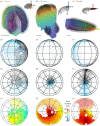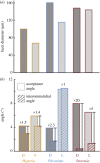Functional differences between the extraordinary eyes of deep-sea hyperiid amphipods
- PMID: 38808445
- PMCID: PMC11285923
- DOI: 10.1098/rspb.2024.0239
Functional differences between the extraordinary eyes of deep-sea hyperiid amphipods
Abstract
The ocean's midwater is a uniquely challenging yet predictable and simple visual environment. The need to see without being seen in this dim, open habitat has led to extraordinary visual adaptations. To understand these adaptations, we compared the morphological and functional differences between the eyes of three hyperiid amphipods-Hyperia galba, Streetsia challengeri and Phronima sedentaria. Combining micro-CT data with computational modelling, we mapped visual field topography and predicted detection distances for visual targets viewed in different directions through mesopelagic depths. Hyperia's eyes provide a wide visual field optimized for spatial vision over short distances, while Phronima's and Streetsia's eyes have the potential to achieve greater sensitivity and longer detection distances using spatial summation. These improvements come at the cost of smaller visual fields, but this loss is compensated for by a second pair of eyes in Phronima and by behaviour in Streetsia. The need to improve sensitivity while minimizing visible eye size to maintain crypsis has likely driven the evolution of hyperiid eye diversity. Our results provide an integrative look at how these elusive animals have adapted to the unique visual challenges of the mesopelagic.
Keywords: low light vision; midwater adaptations; retinal topography; spatial summation; visual field.
Conflict of interest statement
We declare we have no competing interests.
Figures



Similar articles
-
A new computational model illuminates the extraordinary eyes of Phronima.PLoS Comput Biol. 2022 Oct 17;18(10):e1010545. doi: 10.1371/journal.pcbi.1010545. eCollection 2022 Oct. PLoS Comput Biol. 2022. PMID: 36251706 Free PMC article.
-
A unique apposition compound eye in the mesopelagic hyperiid amphipod Paraphronima gracilis.Curr Biol. 2015 Feb 16;25(4):473-8. doi: 10.1016/j.cub.2014.12.010. Epub 2015 Jan 15. Curr Biol. 2015. PMID: 25601548
-
Vision in the deep sea.Biol Rev Camb Philos Soc. 2004 Aug;79(3):671-712. doi: 10.1017/s1464793103006420. Biol Rev Camb Philos Soc. 2004. PMID: 15366767 Review.
-
The thermal stress response to diel vertical migration in the hyperiid amphipod Phronima sedentaria.Comp Biochem Physiol A Mol Integr Physiol. 2015 Sep;187:20-6. doi: 10.1016/j.cbpa.2015.04.008. Epub 2015 Apr 18. Comp Biochem Physiol A Mol Integr Physiol. 2015. PMID: 25899739
-
Seeing in the deep-sea: visual adaptations in lanternfishes.Philos Trans R Soc Lond B Biol Sci. 2017 Apr 5;372(1717):20160070. doi: 10.1098/rstb.2016.0070. Philos Trans R Soc Lond B Biol Sci. 2017. PMID: 28193815 Free PMC article. Review.
References
-
- Jerlov NG. 1968. Optical oceanography. New York, NY: Elsevier.
MeSH terms
LinkOut - more resources
Full Text Sources

